How the radial heating system works: schemes and wiring options
When deciding how to heat his own house, the owner can choose from a variety of heating technologies. Common to them is a similar set of structural elements, which includes a boiler, a pipe system and heating appliances that directly heat the room.
There are differences in the connection schemes of pipelines, one of its options is a radiant heating system, the characteristics and construction rules of which will be discussed in the article. We described in detail the specifics of the collector wiring, gave options for its device. Outlined the selection criteria for equipment for the construction of circuits.
For a clear perception of the information presented, the text is supplemented by collections of photos, useful schemes, videos.
The content of the article:
Significant Radiation Benefits
The main task of the heating system is to compensate for the heat that the building loses due to the differences between the internal and external temperature of the air, as well as due to the different degree of thermal conductivity of the external walls. Her decision largely depends on correctly chosen pipe layoutsdelivering coolant to devices.
In practice, you can connect all heating devices together using the following methods:
- tee connection;
- radiation (collector) connection, when a separate pair of pipes is supplied to each heating device using the collector for direct and reverse supply of the coolant.
The tee or perimeter type of pipe connection is cheaper. But due to the fact that the devices are connected to each other and connected by a pipeline to a single riser, the system will need to be completely disconnected and released from the coolant to repair a separate radiator or section. Or equipped with bypasses and shutoff valves, which will significantly increase the cost of organizing heating.
With traditional perimeter wiring, the entire pipeline is most often mounted in an open way, less often hidden. Radiant heating systems predominantly laid in walls or floors, as a large number of pipes laid on top of structures negatively affects the interior.
Flush mounting is a system of pipes of the underfloor heating, which in accordance with the technological specifics is arranged according to the radiation scheme. The radial pipeline to the heating devices is also laid in the floor screed in a hidden way, because it is better for technological and architectural reasons.
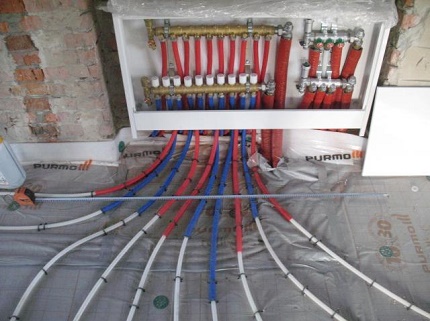
A large number of pipes when using the beam method of assembling pipelines can ruin the interior. Therefore, all heating communications are laid on the floor or walls.
In this case, all joints remain on the surface, so there is practically no risk of leakage under the screed. With a tee system this cannot be done, because when the joints wear, you will have to break the walls and floor.
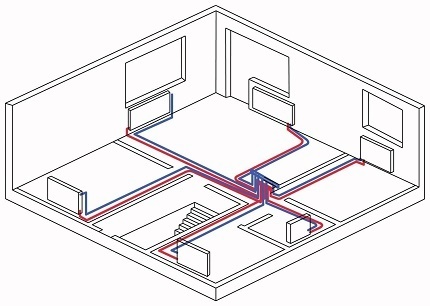
The main disadvantage of the collector wiring is the high material consumption, which consists in a large extent. For normal operation requires technical devices, as it is exclusively forced schemes. And the main plus is that in each room you can set a different temperature, creating a comfortable microclimate in any room.
Each radiator or convector is connected independently, which is also convenient for carrying out maintenance work and replacing worn-out system elements without having to turn off the heating in the entire house or apartment.
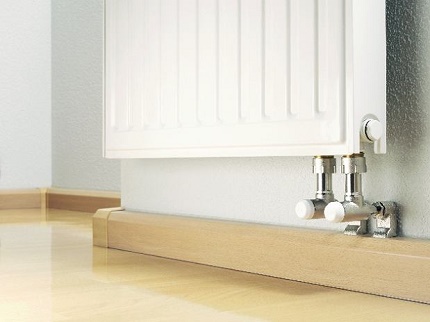
The principle of organization of the beam scheme
One of the central elements of the radiation system is collector unit. If you are going to make heating in a house with several floors, then the collector should be located at each level.
Collectors during installation are placed in a collector cabinet, where a convenient arrangement of this element for subsequent maintenance or adjustment is provided.
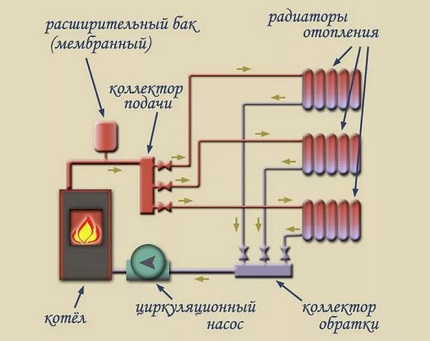
An indisputable advantage of the radiation system is the minimum number of connections, which positively affects the hydraulic stability of the entire heating system. The central working body is the boiler.
To ensure high efficiency and safety, the owner needs to take into account the power of the unit, the consumption of thermal energy by heating devices and the heat loss of the system. This must be done, regardless of the type of fuel the boiler is running on.
An increase in the length of the pipeline when creating a beam wiring is fraught with a slight increase in heat loss, which also needs to be taken into account for a balance of capacities.
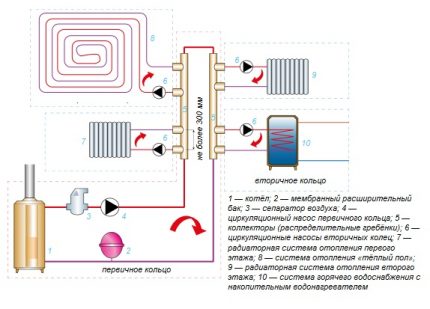
Choose a circulation pump
Radial piping is used mainly in horizontal circuits with a lower flow of coolant. It requires a circulation pump that stimulates the movement of heated water along numerous branches.
The controlled circulation of the heat carrier makes it possible to reduce the temperature difference at the inlet and outlet of the heating circuit. As a result, it is possible to increase the heating efficiency, making the system more compact and less material-intensive.

This unit is selected according to several important parameters, including:
- productivity, m3/hour;
- head height, m.
To correctly pick up the circulation pump under these parameters, it is necessary to take into account the diameter of the pipes, their length and height relative to the location of the pump unit. When drawing up a project for installing a heating system, these parameters are calculated in advance.
Circulation pump installation rules
Adhering to the recommendations below, you can achieve high efficiency and heating safety:
- wet rotary circulation pumps are installed so that the shaft has a horizontal position;
- the device with the thermostat should not be close to hot surfaces (radiator or boiler) so that the readings are not distorted;
- usually installed in the return section of the pipeline due to lower temperatures. Modern models can also be mounted in the supply line, withstanding high temperature conditions;
- The heating circuit must be equipped with an air bleed mechanism. If not, then the pump must have an air vent;
- should be located as close as possible to the expansion tank;
- Before installing the pump, it is recommended to flush the system to remove solid particles;
- before starting the pump, fill the system with water;
In order not to become a victim of excessive noise, choose a pump in accordance with the performance of the heating system.
Is it possible without a pump?
Of course, you can save money and not buy a pump, air vents for air bleeding, sensors, etc. But a radiation system with natural circulation requires the observance of several not very convenient conditions.
Experts recommend this option in extremely rare cases. Firstly, you need to install pipes of wide diameter.Secondly, the expansion tank must be installed at the highest point of the facility.

This option is suitable for a summer residence or other object modest in area, providing enough heat. The choice between natural circulation and forced circulation should be made at the design stage.
Choose a distribution manifold
This device is also called distribution comb. It serves to supply coolant to each heating device (underfloor heating, radiator, convector, etc.). By means of a collector, a return flow also occurs, which then enters the boiler or is again mixed into the circuit to adjust the temperature.
The collector can support from 2 to 12 loops. Some manufacturers offer even more branches for complex projects.
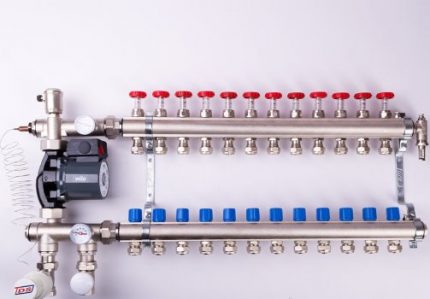
Combs are often equipped with additional locking-regulating and thermoregulating elements. They allow you to set the optimal flow rate for each heating branch. The presence of air vents ensures a more efficient and safe operation of the system.
Beam wiring diagram
Choosing a heating scheme, in most cases they stop on a beam floor wiring of the pipeline. All pipes are hidden from view in the thickness of the floor. Collector - the main distribution body is installed in the niche of the wall fence, often in a special cabinet located in the center of the house / apartment.
In the vast majority of cases, the implementation of radiation wiring requires a circulation pump, and sometimes several, installed on each ring or branch. Its necessity is described above. Radial wiring of the heating system assembly is most often performed on the basis of one- and two-pipe installation, almost completely displacing the tee type of connection.
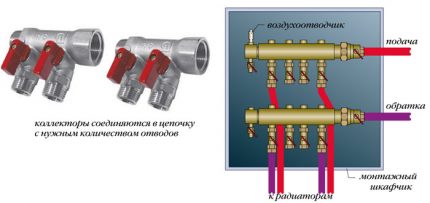
On each floor near the riser of the two-pipe system, the supply and return manifolds are mounted. Under the floor, pipes from both collectors pass in the wall or under the floor and are connected to each radiator within the floor.
Each of the contours should have approximately the same length. If this cannot be achieved, then each ring must be equipped with its own circulation pump and automation to adjust the temperature.
In this case, the change in temperature will be completely independent on each circuit and will not affect each other. Because the pipeline will be under the screed, each radiator must be equipped with an air crane. The air vent can also be placed on the manifold.
What needs to be done before installation?
Before starting work, the task of the owner is to select all components and equipment locations correctly, namely:
- determine location radiators;
- choose type of radiators, based on the pressure indicators and the type of coolant, as well as determine the number of sections or the area of the panels (to calculate the heat loss and calculate the heat capacity needed for high-quality heating of each room);
- sketch the arrangement of radiators and routes of the pipeline, not forgetting about the other elements of the heating system (boiler, collectors, pump, etc.);
- make a paper list all items and make purchases. In order not to make a mistake in the calculation, you can invite a specialist.
So, to proceed to the next stage, it is necessary to take into account the installation rules of the radiation system
Beam installation rules
If you choose to lay pipes under the floor, follow a few rules that will help to avoid heat loss and freezing of the coolant. There should be enough space between the rough and finish floors (more on this later in the description).
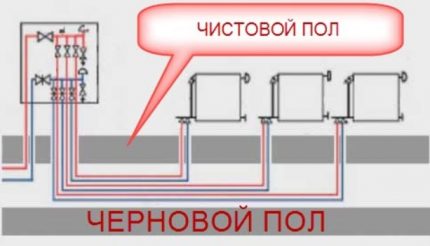
The subfloor may be a concrete foundation slab. First, a layer of insulation is laid on it, then a pipeline is arranged. If pipes are laid without a heat-insulating substrate, then the water in these areas can freeze, losing a lot of heat.
As for pipes, it is better to opt for polyethylene or metal-plastic models that have high flexibility. The polypropylene pipeline bends poorly, therefore, it is not suitable for radiation wiring.
In most cases, a pipe with a diameter of 16 - 20 mm is used (if the radiator power is more than 1.5 kW, then 20 mm), on which a heat-insulating corrugation is put on to reduce heat loss and compensate for thermal expansion.
The pipeline must be attached to the base so that it does not float during pouring with a finishing layer of screed. You can fix it using mounting tape, plastic clamps or other available methods.
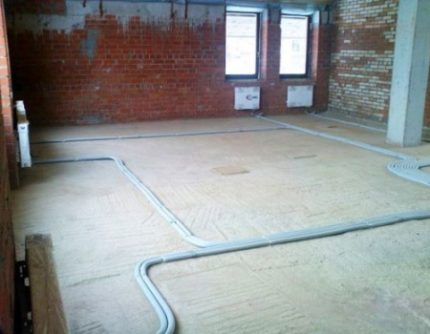
Then around the pipeline we lay the insulation with a layer of 50 mm made of foam or foam. We also fasten the insulation to the base of the floor with the help of dowels-nails. The final step is to fill the solution with a layer of 5-7 cm, which will serve as the basis of the finishing floor. On this surface you can already lay any floor covering.
If pipes are laid on the second floor or higher, the installation of a thermal insulation layer is optional. Remember one important rule, there should be no connections in sections of the pipeline below the floor.
In the presence of circulation pump of sufficient power and performance, the collector is sometimes placed a floor lower relative to the level of location of the radiators.
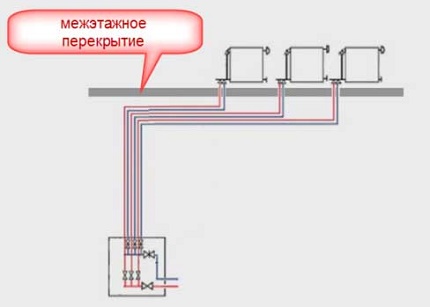
From the manifold, the pipes rise vertically to the ceiling. Then a bend is made and a pipeline along the ceiling is brought to each radiator with one more bend of 90 degrees. The pipes must be fixed to the ceiling. Thus, the vertical pipe through the ceiling is connected to each heater.
Beam wiring and floor heating
The radiation scheme can also be used to equip the “warm” floor system. With a well-designed project, taking into account all factors, you can abandon radiators, making a heated floor the main source for heating.
Heat flows will be evenly distributed throughout the room, without creating a convection effect, unlike radiators. As a result, there is no dust circulation in the air.
Before embarking on the implementation of the idea of installing underfloor heating, it is important to consider the following features:
- a reflective screen with a layer of thermal insulation is laid on a concrete or wooden base;
- pipes are laid on top in a loop-like pattern;
- Before pouring concrete, a hydraulic test of the system is performed under pressure throughout the day;
- the finish layer is a screed or flooring.
The collector of each circuit should be equipped with flow meters and thermostatic valves, which allow precise control of the flow of coolant and regulate its temperature.
When piping, thermostatic heads and servos can be used.These devices allow you to automate the work of a warm floor. The system will respond to changes in room temperature, setting a comfortable mode for each room.

During installation, it is extremely important to fix the pipes correctly before filling everything with a screed. To do this, you can use insulation with grooves, reinforcing mesh or staples.
Before laying the pipeline, it is necessary to clearly determine the route that the coolant will travel to heat the floor (do not allow pipes to cross). It is best to cut the pipe only after full installation and connection to the return and supply manifolds.
It is important that the pipeline is pressurized during filling. Until the concrete mixture has hardened completely and three weeks have passed, it is impossible to supply a coolant with an operating temperature. Only then we start at 25ºС and after 4 days we finish with the design temperature.
Options for wooden houses
To lay the pipeline in a wooden base, it is necessary to drill holes in the wooden beams of the ceiling. In this case, the holes should be slightly larger than the diameter of the pipes so that the beam and the entire structure do not create pressure on the pipeline.
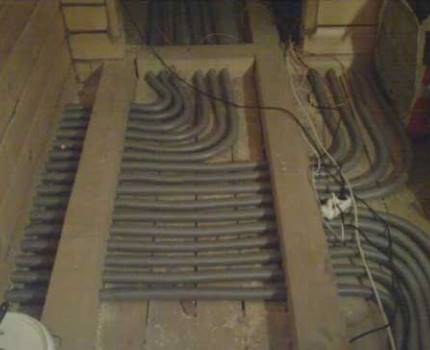
In our example, the rough floor is wooden, on which the pipe system is located. Again, there should not be any joints in the thickness of the floor, because they should be located exclusively above the floor.
Parsing Pros and Cons
Let's start with the cons. In addition to the material consumption, which affects the cost of the project, there is a need to install a collector cabinet, which will require additional space.
On this, the shortcomings of the radiation system end, and a ridge of advantages begins:
- simple design and installation, pipes of the same diameter are used within the system;
- for flush mounting in the walls and floor there are no connections;
- high installation speed due to the minimum number of connections;
- expansion of functionality due to the installation of valves, sensors, air vents and thermal heads to automate the operation of the heating system;
- temperature control in each separate room, using mechanical elements or automation;
- the ability to cut off any radiator without stopping the heating process;
- uniform heating of all rooms.
The external control panel allows you to program the operation of heating, including automatic adjustment depending on weather conditions on the street. Thanks to the installed sensors, all residents can set any parameters that are comfortable for them, being in a particular room.

Thus, the beam layout of the wiring allows you to achieve high controllability of the heating system and achieve optimal flow rate.
Conclusions and useful video on the topic
The clip will help to visually understand the installation features and understand how the heating system with beam distribution works:
An energy-efficient heating system is a balanced combination of all its components. Pipe routing serves as a kind of circulatory system for heating. The beam method of installing the pipeline allows you to deliver exactly as much coolant as each working device needs for its optimal operation.
Do you want to ask questions about obscure points that interested you in familiarizing yourself with the material? Would you like to communicate useful subtleties on the design of radiation systems? Please write comments in the block below.

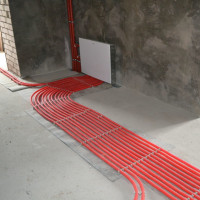 Collector heating system: wiring diagrams for private houses and apartments
Collector heating system: wiring diagrams for private houses and apartments 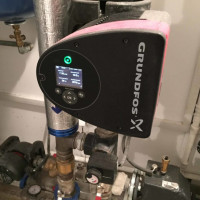 Compulsory circulation water heating system: schemes, implementation options, technical details
Compulsory circulation water heating system: schemes, implementation options, technical details 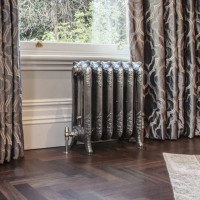 One-pipe heating system Leningradka: schemes and organization principle
One-pipe heating system Leningradka: schemes and organization principle 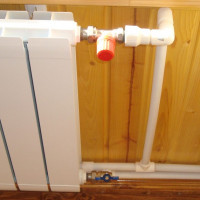 Two-pipe heating system of a private house: device diagrams + overview of the advantages
Two-pipe heating system of a private house: device diagrams + overview of the advantages 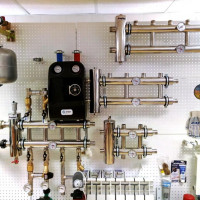 Natural circulation heating system: common water circuit designs
Natural circulation heating system: common water circuit designs  How much does it cost to connect gas to a private house: the price of organizing gas supply
How much does it cost to connect gas to a private house: the price of organizing gas supply  The best washing machines with dryer: model rating and customer tips
The best washing machines with dryer: model rating and customer tips  What is the color temperature of light and the nuances of choosing the temperature of the lamps to suit your needs
What is the color temperature of light and the nuances of choosing the temperature of the lamps to suit your needs  Replacement of a geyser in an apartment: replacement paperwork + basic norms and requirements
Replacement of a geyser in an apartment: replacement paperwork + basic norms and requirements